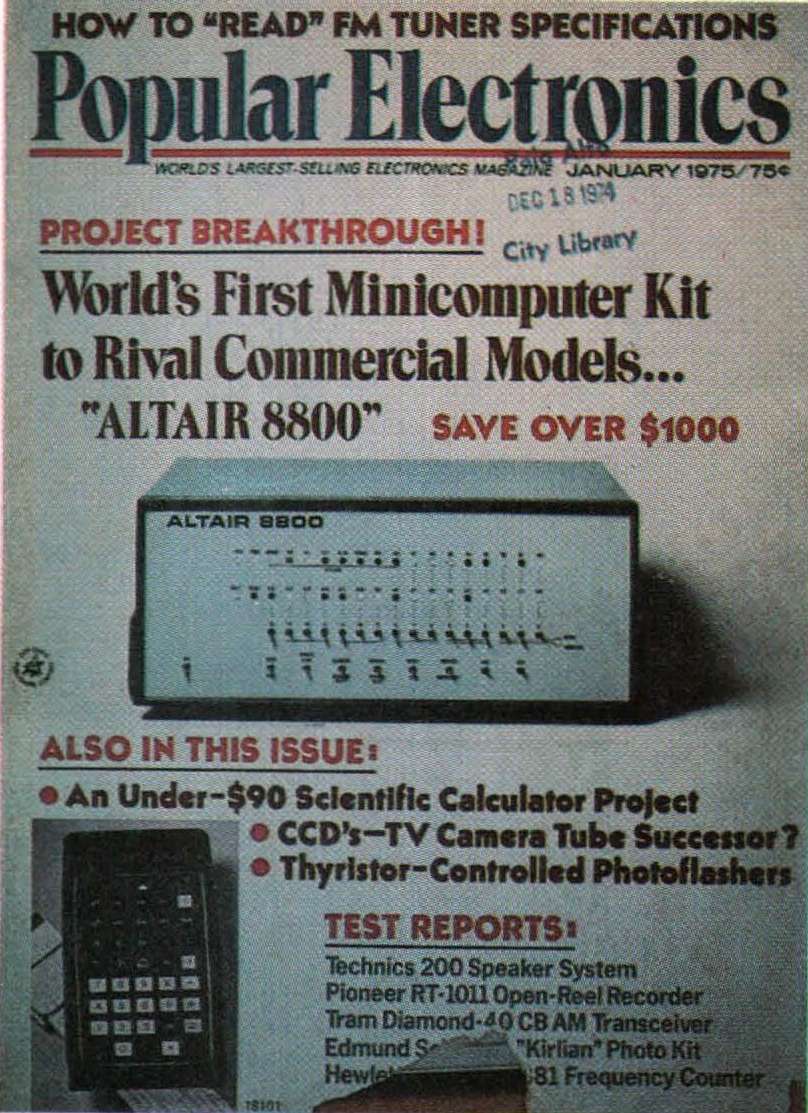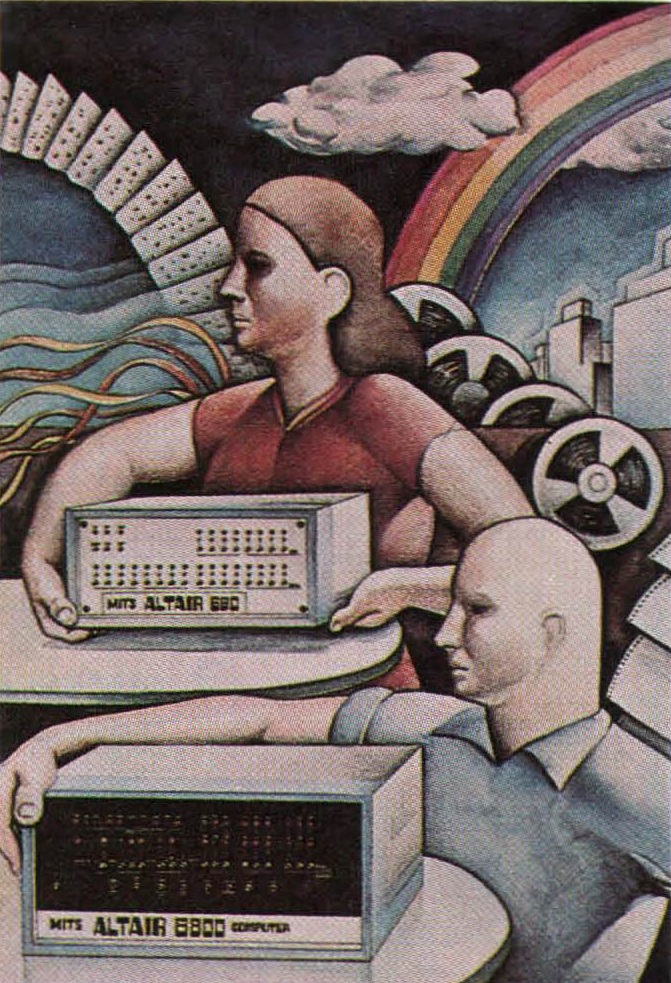The Altair was designed by Roberts and two engineers, William Yates, a former Air Force officer with a degree in aeronautical engineering, and Jim Bybee, another ex-Air Force officer and electronics engineer. Roberts sketched out the general plan and Yates, a quiet, serious man with a knack for electronics, laid out the circuit boards, planning the pathways for each electrical signal. At the start of the project Roberts made a very clever decision: he made sure that the Altair would be easy to expand. A typical minicomputer contained slots for the installation of additional circuit boards, whether for memory or other functions; these slots not only enabled users to enlarge the capacity of their machines, but gave the computer manufacturer a lucrative aftermarket. (It was also an open invitation to other companies to offer boards of their own.) The Altair, beginning a trend that succeeding personal computer manufacturers followed, contained sixteen slots for extra boards.
While Roberts, Yates, and Bybee were building the computer, MITS was about $300,000 in debt and running out of money. Hard pressed, Roberts applied for a $65,000 loan. Half comprehendingly, the Fidelity National loan officer listened to his plans: MITS intended to market a computer kit through ads in electronic hobbyist magazines, offering the gadget, unassembled, for less than $400. MITS also intended to sell peripheral products, such as memory boards, paper-tape readers, and so on, but not at first. At the moment, Roberts said, there was no other product like the Altair and he expected to sell at least eight hundred machines a year. Although the loan officer had his doubts about the eight hundred figure – two hundred seemed to be a more realistic estimate – he granted the loan. The bank wanted to keep MITS, and thereby its chances of repaying its debts, alive.
In the summer of 1974, Roberts put the one and only Altair in a crate and shipped it to New York for Salsberg and Solomon’s evaluation. However, the package, sent via Railway Express, didn’t arrive at the appointed time. Assuring the editors that the machine was on its way – that it probably had been delayed somewhere along the line – Roberts flew to New York to deliver his articles and to demonstrate the Altair. Yet the computer still wasn’t there when he reached New York; it had been lost in transit, and MITS couldn’t possibly assemble another machine in time for the magazine’s deadline. (The package turned up a year later.) Instead, Popular Electronics decided to fake it. Yates and Bybee assembled the outer shell of an Altair, placed some flashing lights on the front, and shipped it to New York, where Popular Electronics photographed it for the front cover. No one was the wiser.

Unlike Radio-Electronics, which had been subdued in its treatment of the Mark-8, Popular Electronics proclaimed the arrival of the “home computer” with appropriate fanfare. The Altair was prominently featured on the cover of its January 1975 issue, and Salsberg, writing in the editor’s column, announced:
For many years, we’ve been reading and hearing about how computers will one day be a household item. Therefore, we’re especially proud to present in this issue the first commercial type of minicomputer project ever published that’s priced within reach of many households – the Altair 8800, with an under-$400 complete kit cost, including cabinet.
To give you some insight into our editorial goal for this momentous project, we were determined not to present a digital computer demonstrator with blinking LED’s [light-emitting diodes] that would simply be fun to build and watch, but suffer from limited usefulness . . . . What we wanted for our readers was a state-of-the-art minicomputer whose capabilities would match those of currently available units at a mere fraction of the cost.
After turning down three computer project proposals that did not meet these requirements, the breakthrough was made possible with the availability of the Intel 8080 … the highest performance, single-chip processor available at this time. As a result, the Altair 8800 offers up to 65,000 words [containing eight bits each] of memory, 256 inputs and outputs simultaneously, buss line expansion [for additional boards], subroutines that are enormously deep, and fast cycle time, among other desirable characteristics. Peripheral equipment such as a “smart” CRT terminal is expected to be available, too, to make up a within-pocketbook-reach sophisticated minicomputer system.

Although MITS’s ads promised delivery within sixty days, the firm was swamped with orders, and it didn’t manage to fill the bulk of them until the summer. Even so, most of the promised optional equipment, such as printers, paper-tape readers, memory boards, and terminals, wasn’t available until the end of the year. Nor did MITS have any prepackaged software; if you wanted to get the Altair to do something – anything – you had to write a program in machine code and enter it, bit by bit, via the toggle switches on the front panel. Moreover, the 256-byte basic memory was too small to allow the Altair to do much, Salsberg’s comments notwithstanding. As a result, all you could really do with the Altair was play with it, and one of its first programs was a game that generated increasingly complicated patterns of lights on the front panel, patterns that had to be duplicated by the players. (The game resembled a popular toy, called Simon, that appeared a few years later.)

What the Altair needed most of all, aside from more memory and peripherals, was a BASIC interpreter. Such an internal program would enable the machine’s users (assuming they had a paper-tape reader) to write programs in BASIC, a popular, easy-to-use high-level language, rather than in machine code. As coincidence would have it, Paul Allen, a young programmer who worked outside Boston, happened to be strolling through Harvard Square one day when he noticed the January issue of Popular Electronics on a newsstand. A computer hobbyist since junior high school, Allen bought a copy and went on to visit his friend William Gates, a Harvard freshman. Enterprising young men, Allen and Gates phoned Roberts with an offer to write a BASIC interpreter for the Altair. Roberts was interested, and the pair got to work. Six weeks later, Allen flew out to Albuquerque with the interpreter. Roberts bought it, and Allen promptly became MITS’s software director. Meanwhile, Gates dropped out of Harvard and went to work as a freelance software writer. Gates and Allen later established the Microsoft Corporation, in Bellevue, Washington, and it is now one of the country’s largest software companies.

Other people got into the act, too. Although MITS eventually offered 4K memory boards for $150, the first boards didn’t work well, and another company, Processor Technology, of Berkeley, California, arose to supply them. Operating out of a garage, Processor Technology was typical of the computer companies that cropped up in the wake of the Altair’s appearance. It was small, undercapitalized, and amateurish, but overflowing with optimism and good intentions. It went on to make a personal computer of its own and enjoyed some success; by 1977, the company had about ninety employees and occupied a large building in Emeryville, California, southwest of Berkeley. By that time, however, there were at least thirty personal computer companies, including Apple, IMSAI, Commodore, Vector Graphic, Heathkit, Cromemco, Radio Shack, North Star, and MITS. A highly competitive personal computer industry was springing up, with an infrastructure of its own – trade fairs (the First World Altair Computer Conference, in Albuquerque in March 1976); magazines (Byte, in August 1975); and computer shops (The Computer Store, in Los Angeles, in July 1975).
Meanwhile, Edward Roberts, unhappy in his role as manager, decided to sell out. On 22 May 1977, MITS was acquired by the Pertec Computer Corporation (now known as TA Pertec and based in Chatsworth. California), a firm that made disk and tape drives for minicomputers and mainframes. Roberts and MITS’s other stockholders received $6.5 million in Pertec stock; Pertec sent in its own management team; and MITS began to collapse. In the first place, MITS no longer monopolized the personal computer market; in fact, IMSAI, whose computer was essentially an enhanced version of the Altair, pulled ahead of MITS with a zealous sales effort that focused on small businesses. Pertec also decided to concentrate on the business market, but the Altair wasn’t efficient enough for the needs of small businesses and small businesses weren’t ready for personal computers. In the second place, small personal computers with built-in monitors, keyboards, and disk drives were beginning to appear. Easier to use, these machines appealed to the general public, but Pertec had nothing similar. By 1979, both MITS and IMSAI were bankrupt.